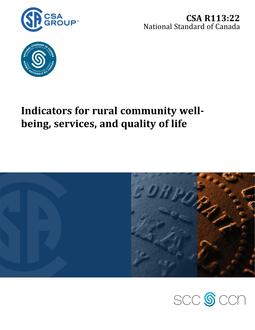Preface
This is the first edition of CSA R113, Indicators for rural community well-being, services, and quality of life . This Standard has been developed in compliance with Standards Council of Canada requirements for National Standards of Canada. It has been published as a National Standard of Canada by CSA Group.
Scope
1.1 Overview This Standard provides definitions and methodologies for a set of indicators to identify and measure community well-being, prosperity, and sustainability in rural and small-town contexts, as well as requirements and recommendations for data access and utilization. It is intended to promote the consistent use of common definitions and the measurement of seven key indicators of conditions in communities, as follows: a) economic (Clause 5); b) environmental (Clause 6); c) health (Clause 7); d) housing (Clause 8); e) institutional (Clause 9); f) population (Clause 10); and g) social and cultural (Clause 11). Note: Some indicators measure factors that are outside the control of the community but provide important context for understanding quality of life issues and related influences. This Standard will support a wide range of community goals and action by encouraging the use of evidence that facilitates meaningful comparisons of communities, establishment of benchmarks and targets, measurement of progress on community sustainability and quality of life, and evaluation of the effectiveness of community development policies and programs. Several of the indicators could benefit from community initiatives to collect and analyze local information. In those cases, resources to help this process should be provided. Local communities can consider existing research instruments and approaches in their development. Using existing instruments will not only improve the validity of the information, but will provide opportunities for comparative analysis with other locations.
1.2 Users This Standard is designed to be a resource for staff and officials in rural and small-town municipalities and organizations who work in fields related to rural community well-being, prosperity, and sustainability. Government departments and agencies, as well as non-government organizations, can use this Standard to facilitate the design, implementation, and evaluation of policies and programs involving rural communities. Researchers involved in rural community analysis can benefit from the use of this Standard, as it can enable analysis based on consistent definitions and measures of key indicators regarding rural community conditions.
1.3 Application While this Standard is designed to be most useful for analysis of rural and small-town communities, it could also be useful for small-area analysis in urban contexts. Very small or remote communities often face challenges with the availability of local data to support some of the indicators articulated in this Standard. Some guidance around methods for addressing data availability issues is included in Clause 4. This Standard does not express or imply a hierarchy of domains or a value judgment regarding the relative merit of particular indicators. The indicators are covered in alphabetical order in Clauses 5to 11. The intent is that the indicators and measures presented in this Standard will be applicable to a wide range of rural and remote communities in Canada irrespective of ethnicity, culture, or history. The knowledge and experience of Indigenous populations and possible unique circumstances of Indigenous communities are also recognized, and the intent is that this Standard can be adapted and used for Indigenous communities, as applicable. It is similarly recognized that there are numerous Indigenous-led data and Standards initiatives in Canada, and that this Standard is a more generic rural complement.
1.4 Terminology In this Standard, “shall” is used to express a requirement, i.e., a provision that the user is obliged to satisfy in order to comply with the Standard; “should” is used to express a recommendation or that which is advised but not required; and “may” is used to express an option or that which is permissible within the limits of the Standard. Notes accompanying clauses do not include requirements or alternative requirements; the purpose of a note accompanying a clause is to separate from the text explanatory or informative material. Notes to tables and figures are considered part of the table or figure and may be written as requirements. Annexes are designated normative (mandatory) or informative (nonmandatory) to define their application.
Product Details
- Edition:
- 1st
- Published:
- 02/01/2022
- ISBN(s):
- 9781488341663
- Number of Pages:
- 49
- File Size:
- 1 file , 1.1 MB
- Product Code(s):
- 2429888, 2429887, 2429888, 2429887
- Note:
- This product is unavailable in Belarus, Russia, Ukraine
